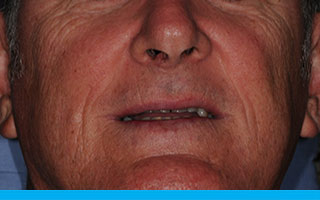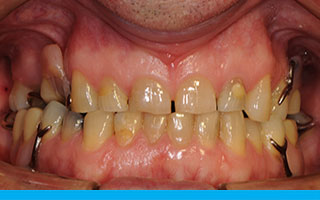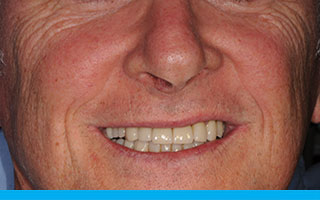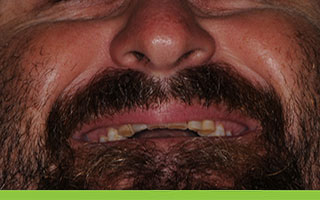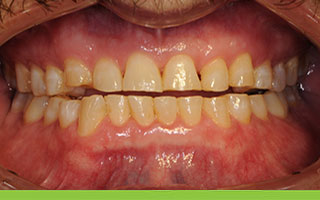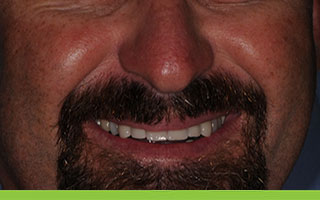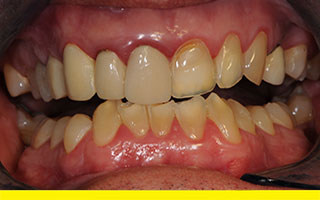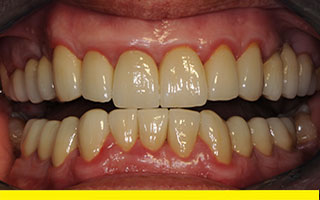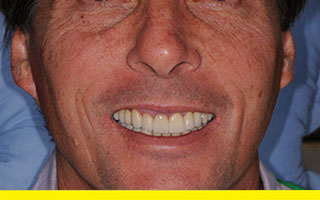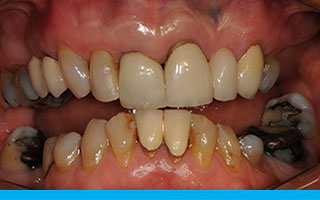Oral Rehabilitation – Occlusal Bite Reconstruction
Full mouth ‘Oral Rehabilitation’ should be performed with an emphasis of an ‘Occlusal Bite Reconstruction’ not just aesthetics. Bite reconstruction can be either Partial Bite Reconstruction or Full Bite Reconstruction.
A. Partial bite reconstruction – left right and forward bites
After bite adjustment and hinge bite you will have a protective hinge bite, that is balanced left to right side on the back teeth. However, your prosthodontist will inform you that maybe one, two or three of your other bites are unprotected.
For example, your left bite may be unprotected because you have worn your lower left canine tooth away from grinding at night.
This tooth may need a composite resin overlay, porcelain veneer or ideally a crown to create a left protective bite.
B. Full mouth bite reconstruction
Full mouth bite reconstruction usually involves building up all the teeth at once because most of the teeth have worn down too much with age. When the worn out teeth are built up a variety of restorative materials can be used. This includes:
- Composite resin overlays
- Porcelain veneers
- Crowns and bridges
- Implant crowns and implant dentures
This building up process will increase the facial height (nose to chin distance) of the patient back to the age of 25 years old and is called increased vertical dimension.
Showcase of Full Mouth Bite Reconstruction (Rehabilitation) of recent Patient Cases
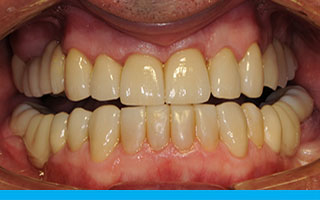
After – Finished crowns & fixed bridges for full mouth occlusal (bite) reconstruction (rehabilitation).
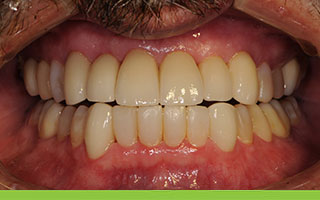
After – Final occlusal bite reconstruction (rehabilitation) using some resin overlays lower incisors, remainder crowns
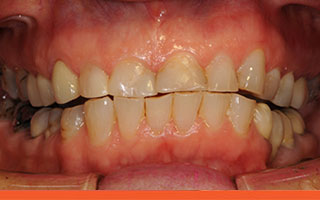
Before – Short worn damaged angled teeth.
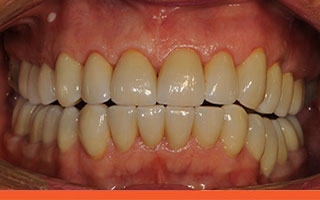
After – Finished ‘straight’ crowns following full mouth occlusal (bite) reconstruction (rehabilitation).
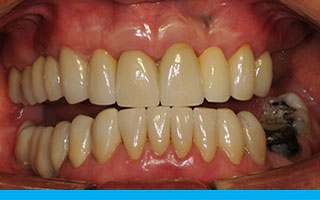
After – Finished crowns and bridge for full mouth occlusal (bite) reconstruction (rehabilitation) but treatment ongoing on patients left side.
Repositioning teeth involves Orthodontist treatment
Your referral to an orthodontist is for repositioning your very poorly arranged teeth so that prosthodontic occlusal (bite) therapy will be more successful. Also, if an orthodontist can reposition your teeth optimally, your teeth may not need crowns or other restorative procedures. However, this ideal situation only occurs when there is no mismatching of the tooth size and jaw size. We only precisely know this towards the end of Orthodontic Therapy.
As mentioned, there are 4 bites, namely, hinge, right, left and forward bites. Each of these bites must be made protective to prevent premature cracking or wear of teeth or painful facial muscles or jaw joints. Also, protective bites are largely responsible for keeping teeth from drifting after orthodontics.
In some cases, an orthodontist can re-arrange all your teeth but not achieve even one fully protective bite. However, what the orthodontist does do is place the teeth in a position that makes it possible and easier for a prosthodontist to bio-design protective bites.
During your orthodontic treatment, your orthodontist will refer you back to Your Dental Specialist for an occlusal bite evaluation and for further recommendations in the management of your treatment. Two or three consultations with Your Dental Specialist during orthodontics are often necessary before both the orthodontist and I are happy to remove the braces.
Occlusal Prosthodontic treatment
During these consultations, the likely need for occlusal prosthodontic treatment will become evident to all of us. The various treatments that may need to be performed on the day or several days after the braces are removed include:
- Occlusal bite adjustment or spot grinding of back teeth to create mini flat helicopter landing pads for the points or cusps to create a protective hinge bite on the back teeth – left to right sides.
- Bonding or splinting of the lower incisor teeth (in a hygienic manner) with composite resin to prevent drifting when an orthodontic splinting wire is not indicated.
- Placing crowns or resin overlays or porcelain veneers on the lower canine teeth to create left and right protective bites.
- Building-up upper incisor or canine teeth with the bonded composite resin overlays to help create forward or left and right protective bites.

